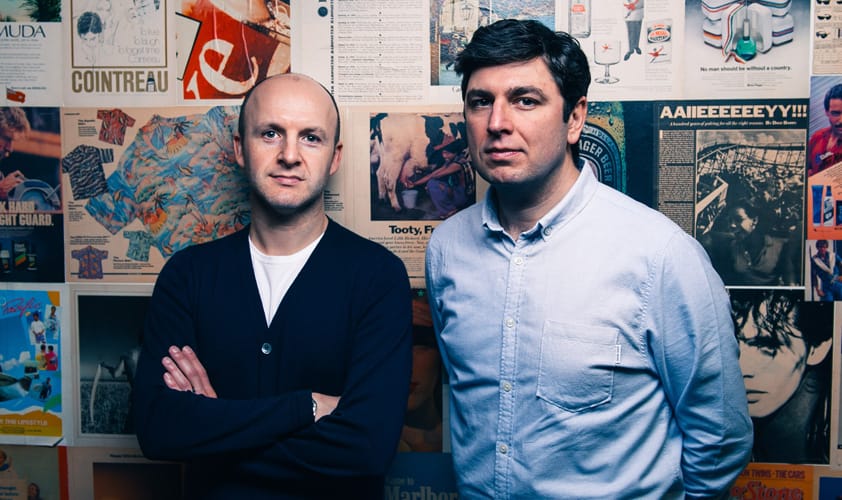Reading the room is an essential skill in PR.
Although I failed that spectacularly when I first stepped foot inside a PR agency, fifteen years ago in London.
“You don’t belong here,” I was told bluntly by Mitch Kaye, the Managing Director of Mischief PR.
And yet that agency, as it existed back then, shapes our approach today here at Absolutely Baltic. It was everything that clients and journalists should expect from a good PR agency, even with all the changes to the information landscape since then. Let me tell you why.
Rewind
My mistake had begun earlier that morning when I’d carefully polished my shoes and picked out just the right tie to make me look the most professional for that meeting with Mitch.
I’d been working as a tabloid journalist, but was ready to make the switch to PR. And I knew Mischief was the most headline-grabbing new agency.
Mitch met me at the door and walked me through the office. Between its exposed red brick walls were creative professionals working away to club music, representing Britain’s coolest consumer brands, while decked out in jeans, nice shirts, and brightly coloured trainers.
“Who else are you interviewing with?” Mitch asked me once we’d sat down.
I explained that I was at the final interview stage for Finsbury, the swanky financial PR agency over in the City. My hope that gave me leverage was quickly dashed.
“Yep, you’ll fit in well there,” he said. “But not here. Look around you. Do you see anyone else here in a suit and tie?"
He had a point.
In school, we’re often taught there’s a correct way to do everything, including how to look professional. It’s formulaic. And so it simply never occurred to me that you could turn up to a job interview without formal attire.
Of course, this was about much more than a suit. Mitch was looking for people who could understand audiences and break conventions. He wanted people who were mischievous about getting results.
On the walls behind him were photos of all their best work, proudly displayed in ornate golden frames. They were wildly creative, resulting in the kind of news stories you remember and even laugh about with your friends.
They’d hired philosopher Alain de Botton to be Heathrow airport’s writer-in-residence for a week, for example, generating heaps of fascinated global media coverage as he sat behind his desk in the middle of Terminal 5.

I really wanted to help them make more newsworthy stories like this. Fortunately, I did have one trick up my sleeve.
As Mitch attempted to wrap up the interview early, I pulled out a document and passed it across to him. It was mostly just my portfolio of journalism but with an opening page explaining how my experience would benefit Mischief. The document was as thick as a bible, neatly bound, and had a great cover too with pictures of their clients.
It was ridiculously over-the-top, but it left zero doubt that I’d done my research and understood both their clients and their work.
“Before you reject me, just give me one week’s work experience and I’ll show you that I can pull off great PR stunts,” I pleaded.
He relented - and later that day held an all company meeting in which he held up the document.
“This is the lengths people will go to just to get a foot in the door here,” he explained. Sometimes you actually can judge a book by its cover.
That week work experience turned into a six month graduate scheme, which turned into a few years, eventually rising to the role of news consultant for the agency as it tripled in size to nearly 100 employees.
Before I walked out of the interview though, Mitch pointed out one more mistake I’d made.
“We don’t do stunts, but you’ll learn that soon enough.”
I did indeed. Take that example with Alain de Botton. He wasn’t just at Heathrow for a photo op. His week-long residency was part of a deal to produce a short book about the airport - and people are still buying it.
Alain had unrestricted access and complete editorial freedom to produce a book that was actually interesting. The end result, A Week At The Airport: A Heathrow Diary, became a best seller with thousands of positive reviews. It gave a new sense of wonder and transparency to Europe’s busiest airport. As one Good Reads reviewer explains, De Botton managed to make even the M4 sound poetic.
We would later repeat the success with a refreshed approach, hiring novelist Tony Parsons to create a series of short fiction stories set in the airport. It worked just as well again.
What kind of PR agency is not only able to create this level of sentiment at this scale, but actually turn a profit for the client in the process?
Making mischief
Under the leadership of Mitch Kaye and creative director Dan Glover, Mischief PR was a well-oiled news-creating machine.
In the corner of the room sat 'the Grid', listing a huge variety of upcoming news stories planned for the following weeks, as we were so effective that we didn't want to inadvertently compete with ourselves.
Ideation began early each morning when we’d receive a big bundle of all the day’s newspapers and start scanning through them to see what was getting Britain talking.
In our morning conference, we dissected the stories that particularly caught our eye, whether they gave our clients an opportunity to react, inspired an entirely new idea, or were just particularly good examples of stories originating out of other PR agencies.
“The Queen was snapped driving without a seatbelt,” someone would spot, ripping out the page. By the end of the day, we’d have a polling agency running the numbers on British seatbelt habits and the follow up story we expected to find in the data would be added to the grid. The polling would be commissioned by one of our car insurance clients whose name and key messages would be embedded in the story.
We didn’t rest from the news even at lunch. We’d be dining a journalist so we could then brief the rest of the agency on how their newsroom operates, what kind of stories interested them, and how best to approach them.
Sometimes, you need to pitch a hundred journalists to find the right person who, right at that moment, wants your story. But stick to their rules and you won't annoy them even when they are not interested.
By late afternoon, we might have a dedicated brainstorm about one of our clients involving not just the client team, but a wide range of perspectives from across the agency.
A common criticism of PR agencies is that they’ll send their most senior staff to pitch to a new client but, once the contract is signed, swap them out for junior staff delivering the work.
At Mischief, Dan and all the senior creatives were involved with clients above expectations from the pitch - while also doing a tremendous job of nurturing and supporting younger employees like me.
At one event, a sewage pipe burst at the venue shortly before journalists were due to arrive. I remember seeing Dan, one of the most brilliant minds in PR, running to grab a mop and thoroughly cleaning it up without a moment's thought about whether that was his role. We were all hands-on, even with the less glamorous side that people don't see.
And there was a strong culture of underpromising and overdelivering.
I know a lot of companies that just say that, ironically overpromising on their ability to underpromise. But we were quite methodological about it. Our clients would be kept in the loop about the progress of news announcements but, even when we were brimming with excitement about what we expected, we'd always dial it down for them until we had the results.
Start with bad ideas
In those brainstorms, my favourite exercise began by first imagining we are the world’s worst PR agency and listing all the worst possible headlines we could generate for our clients.
Because the best ideas are then often the polar opposite of the worst.
It’s not enough to simply think of a good news story to flatter your client. You’d end up with something incredibly dull and not at all newsworthy, the kind of press releases that don’t go anywhere beyond a company’s own blog.
But, by thinking first about the worst headlines, you actually have to hone in on things that really sting because they really matter. You have to ground your ideation in real public sentiment and what's really newsworthy. And you can't be afraid of any of that. You have to first acknowledge and address where the real criticism can be found.
And an effective response can’t just be spin. It’s not just about telling a story in the right way. It’s creating a story in the right way, often by actually doing something tangible.
Marketing should not just be about communicating to the market. It’s listening to the market and understanding the market. Good marketers should be communicating that feedback to the business and ensuring it shapes wider strategy going forward.
(Oh, by the way, just don't record any of those deliberately bad ideas and circulate them, even with a note attached saying 'these should not be shared externally', as the UK Foreign Office once did shortly before the Pope made an official visit.)
Embrace criticism
For Heathrow, which handles more than 80 million passengers per year, there was never any shortage of critical feedback.
On one occasion, a mother had a particularly bad experience getting through security with her frightened children. The mother also happened to be a journalist who wrote about it, sparking a wider conversation, particularly in the ‘mummy blogger’ community.
We didn’t ignore it, nor try to spin our way out of it.
Instead, we invited them all to Heathrow to meet with the most senior airport bosses. Bring your children, we told them, we’ll actually make it fun for them - and figure out how to make it fun for all children in future.
They families got a great tour behind the scenes and the parents had a roundtable to tell bosses directly what they think should change to make air travel better for them and their children. Over the following weeks and months, those ideas became reality.
The journalists wrote positively about how they were listened to and, to this day, when I travel through Heathrow now with my own children, I can see some of the legacy of that - with staff better trained to welcome young passengers and information for them at their height about what's happening, but presented in a fun way.
This is what it means to go beyond PR as a series of stunts. PR can help define a business through tangible, lasting change.
Going bigger
One day, the phone rang from defence giant BAE Systems and Mitch initially thought they hadn't done their research well on agencies.
We were a consumer PR agency, afterall, with clients like Ben & Jerry's. And aircraft carriers aren't exactly a consumer product.
But BAE Systems explained that they are fundamentally a tech company and they wanted the best consumer agency to put them in places like Wired, alongside companies like Apple, especially as they were hiring and upskilling on a massive scale. Young people across Britain needed to know that they didn't need an expensive education or to resettle in California in order to design next generation technology.
We pitched our plan to position BAE Systems employees as the real Qs from James Bond and it fundamentally transformed the image and openness of the business.
We scoured the business across the country and found story after story that would have been kept secret unnecessarily - from 'bulletproof custard' body armour to invisible tank technology - and we ensured a steady stream of stories that invoked a deep sense of national pride about people at the cutting edge of innovation.
Until then, BAE Systems had largely confined itself to the niche defence press and the financial pages.
I learnt that you must always keep communicating and always go for the biggest possible audiences. The top politicians and generals are reading mainstream technology news too, much more than any niche publication that attempts to cater just for them. And so too are their families and friends and everyone else who has a stake in this technology.
Every time I'd travel to a BAE Systems site up and down the country, I'd point to a facility and casually ask the local taxi driver taking me to my hotel about what work is being done there, despite knowing full well. The answers would get more detailed and prouder over time.
A impromptu focus group can often tell you more than marketing metrics.
Everything can be news
Mischief was later acquired by Engine, the UK's largest private communications group, filling a corner of Oxford Circus.
Shortly after moving in, Engine held an internal 'redesign the lift' competition in which each of its agencies would take turns to transform the lift into a showcase of its work.
Mischief really went outside the box, not putting up a portfolio, but turning even the lift into a news story that made headlines around the world.

I'll let you google 'world's first lickable lift' for yourself if you want to see more.
Beyond Mischief
After selling their agency, Mitch and Dan started from scratch. They built a new PR agency called the Academy.
As for me, I got to see Mischief from the client-side too. BAE Systems asked me to work for them directly, handling communications for its Naval Ships business, especially to maintain momentum behind the delivery of the Royal Navy's new flagship aircraft carriers, which we launched with Her Majesty and the Prime Minister.
When you look back at photos of those carriers under construction and see a person to scale with his back to the camera then I'm usually that person to scale.

The media landscape has changed dramatically since my days at Mischief, but I strongly believe that many of the fundamentals are the same for what to expect from a good agency.
It needs a strong culture, both creatively for ideation but also with disciplined processes for handling clients, as well as journalists - although while recognising that journalists owe you absolutely nothing.
Good PR professionals need a deep understanding and respect for journalism as its own, very separate profession. I still write journalism as a hobby because I love it so much.
Just remember it is not their job in any way to promote your client so give them something newsworthy and actually valuable for their own audiences.
With that, you can go big. If you've got good stories then it's actually easier to get coverage with big outlets that respect their audiences, rather than those niche pay-to-play media outlets that try to sell access to specific audiences but only really exist to rip off sponsors.
If someone's selling you a spot on a top ten list then that list is junk anyway and no one is going to be reading it. I'd pay not to be on it!
If a company wanted to reach you as part of an audience based on your profession or industry or niche interests then how much media are you really consuming specifically around those identities? I'm sure you are more likely to notice and share something related to your topics in bigger, mainstream outlets.
And I'd now include a lot of non-traditional content creators and influencers in that category of big and mainstream. They've long been sneered at but if they've built audiences that respect them for delivering valuable content.
Even in the age of social media and now AI, traditional PR is hugely underrated. It's still leading conversations that filter through social media and informs AI answers.
The spirit of Mischief PR from the early 2010s has shaped Absolutely Baltic today. In fact, Mitch remains just as supportive as he did then, providing valuable PR advice and encouragement. If you need a far larger UK agency with extensive reach and resources then definitely check out the Academy PR.

